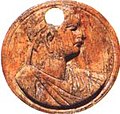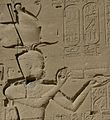Ptolemaic dynasty
| Ptolemies Πτολεμαῖοι | |
|---|---|
| Final head | Drusilla |
| Titles | Pharaoh Basileus of Egypt King of Macedonia King of Mauretania Caesariensis King of Syria King of Cyrene |
| Dissolution | AD 79 |
| Deposition | 279 BC (Macedon) 30 BC (Egypt) AD 40 (Mauretania) |
| Periods and dynasties of ancient Egypt | ||
|---|---|---|
|
All years are BC | ||
| XXXIII | 305–30 |
The Ptolemaic dynasty (
Ptolemy, a general and one of the somatophylakes (bodyguard companions) of Alexander the Great, was appointed satrap of Egypt after Alexander's death in 323 BC. In 305 BC he declared himself Pharaoh Ptolemy I, later known as Sōter "Saviour". The Egyptians soon accepted the Ptolemies as the successors to the pharaohs of independent Egypt. The new dynasty adopted the Egyptian titles and iconography, and respected local traditions, while also preserving their own Greek language and culture.[8][6] The Ptolemaic period was marked by the intense interactions and blending of the Greek and Egyptian cultures.[9] Under the Ptolemies, Hellenistic religion was largely influenced by religious syncretism and imperial cult.[10][11] Elements of Greek education became widespread in urban spaces, culminating in the foundation of the Mouseion (including the Library of Alexandria) and the Serapeum.[12] During the Hellenistic period, the city of Alexandria founded by Alexander the Great would gradually surpass Athens taking its place as the intellectual centre of the Mediterranean world.[13]
Following the earlier dynasties of Egypt, the Ptolemaic dynasty adopted the practice of
Rulers and consorts
- Ptolemy I Soter (303–282 BC)[16] married first Thaïs, then Artakama, then Eurydice, and finally Berenice I
- Ptolemy II Philadelphus (285–246 BC)[17] married Arsinoe I, then Arsinoe II; ruled jointly with Ptolemy Epigonos (267–259 BC)
- Ptolemy III Euergetes (246–221 BC) married Berenice II
- Ptolemy IV Philopator (221–203 BC) married Arsinoe III
- Ptolemy V Epiphanes (203–181 BC) married Cleopatra I Syra
- Cleopatra II, briefly ruled jointly with Ptolemy Eupatorin 152 BC
- Ptolemy VII Neos Philopator (possibly never reigned)
- Cleopatra III; temporarily expelled from Alexandria by Cleopatra II from 131 to 127 BC, then reconciled with her in 124 BC.
- Cleopatra II Philometora Soteira (131–127 BC), in opposition to Ptolemy VIII Physcon
- Ptolemy Apion (c.120-96 BC), son of Ptolemy VIII. Last Ptolemaic king of Cyrene.
- Ptolemy IX Lathyros (116–107 BC) and Ptolemy X Alexander I(107–101 BC)
- Cleopatra IV, then Cleopatra Selene; ruled jointly with Cleopatra III in his first reign
- Berenice III; ruled jointly with Cleopatra III till 101 BC
- Berenice III Philopator(81–80 BC)
- Ptolemy XI Alexander II (80 BC) married and ruled jointly with Berenice III before murdering her; ruled alone for 19 days after that.
- Cleopatra V Tryphaena
- Berenice IV Epiphaneia (58–55 BC), possibly identical with Cleopatra V Tryphaena[18]
- Ptolemy XIV (47–44 BC) and Ptolemy XV Caesarion(44–30 BC).
- Arsinoe IV(48–47 BC), in opposition to Cleopatra
- Ptolemy of Mauretania (13 or 9 BC–AD 40) Client king and ruler of Mauretania for Rome
Dates in brackets on the Cup of the Ptolemies represent the regnal dates of the Ptolemaic pharaohs. They frequently ruled jointly with their wives, who were often also their sisters, aunts or cousins. Several queens exercised regal authority. Of these, one of the last and most famous was Cleopatra ("Cleopatra VII Philopator", 51–30 BC), with her two brothers and her son serving as successive nominal co-rulers. Several systems exist for numbering the later rulers; the one used here is the one most widely employed by modern scholars.
Family tree
| Ptolemaic family tree | |||||||||||||||||||||||||||||||||||||||||||||||||||||||||||||||||||||||||||||||||||||||||||||||||||||||||||||||||||||||||||||||||||||||||||||||||||||||||||||||||||||||||||||||||||||||||||||||||||||||||||||||||||||||||||||||||||||||||||||||||||||||||||||||||||||||||||||||||||||||||||||||||||||||||||||||||||||||||||||||||||||||||||||||||||||||||||||||||||||||||||||||||||||||||||||||||||||||||||||||||||||||||||||||||||||||||||||||||||||||||||||||||||||||||||||||||||||||||||||||||||||||||||||||||||||||||||||||||||||||||||||||||||||||||||||||||||||||||||||||||||||||||||||||||||||||||||||||||||||||||||||||||||||||||||||||||||||||||||||||||||||||||||||||||||||||||||||||||||||||||||||||||||||||||||||||||||||||||||||||||||||||||||||||||||||||||||||||||||||||||||||||||||||||||||||||||||||||||||||||||||||||||||||||||||||||||||||||||||||||||||||||||||||||||||||||||||||||||||||||||||||||||||||||||||||||||||||||||||||||||||||||||||||||||||||||||||||||||||||||||||||||||||||||||||||||||||||||||||||||
|---|---|---|---|---|---|---|---|---|---|---|---|---|---|---|---|---|---|---|---|---|---|---|---|---|---|---|---|---|---|---|---|---|---|---|---|---|---|---|---|---|---|---|---|---|---|---|---|---|---|---|---|---|---|---|---|---|---|---|---|---|---|---|---|---|---|---|---|---|---|---|---|---|---|---|---|---|---|---|---|---|---|---|---|---|---|---|---|---|---|---|---|---|---|---|---|---|---|---|---|---|---|---|---|---|---|---|---|---|---|---|---|---|---|---|---|---|---|---|---|---|---|---|---|---|---|---|---|---|---|---|---|---|---|---|---|---|---|---|---|---|---|---|---|---|---|---|---|---|---|---|---|---|---|---|---|---|---|---|---|---|---|---|---|---|---|---|---|---|---|---|---|---|---|---|---|---|---|---|---|---|---|---|---|---|---|---|---|---|---|---|---|---|---|---|---|---|---|---|---|---|---|---|---|---|---|---|---|---|---|---|---|---|---|---|---|---|---|---|---|---|---|---|---|---|---|---|---|---|---|---|---|---|---|---|---|---|---|---|---|---|---|---|---|---|---|---|---|---|---|---|---|---|---|---|---|---|---|---|---|---|---|---|---|---|---|---|---|---|---|---|---|---|---|---|---|---|---|---|---|---|---|---|---|---|---|---|---|---|---|---|---|---|---|---|---|---|---|---|---|---|---|---|---|---|---|---|---|---|---|---|---|---|---|---|---|---|---|---|---|---|---|---|---|---|---|---|---|---|---|---|---|---|---|---|---|---|---|---|---|---|---|---|---|---|---|---|---|---|---|---|---|---|---|---|---|---|---|---|---|---|---|---|---|---|---|---|---|---|---|---|---|---|---|---|---|---|---|---|---|---|---|---|---|---|---|---|---|---|---|---|---|---|---|---|---|---|---|---|---|---|---|---|---|---|---|---|---|---|---|---|---|---|---|---|---|---|---|---|---|---|---|---|---|---|---|---|---|---|---|---|---|---|---|---|---|---|---|---|---|---|---|---|---|---|---|---|---|---|---|---|---|---|---|---|---|---|---|---|---|---|---|---|---|---|---|---|---|---|---|---|---|---|---|---|---|---|---|---|---|---|---|---|---|---|---|---|---|---|---|---|---|---|---|---|---|---|---|---|---|---|---|---|---|---|---|---|---|---|---|---|---|---|---|---|---|---|---|---|---|---|---|---|---|---|---|---|---|---|---|---|---|---|---|---|---|---|---|---|---|---|---|---|---|---|---|---|---|---|---|---|---|---|---|---|---|---|---|---|---|---|---|---|---|---|---|---|---|---|---|---|---|---|---|---|---|---|---|---|---|---|---|---|---|---|---|---|---|---|---|---|---|---|---|---|---|---|---|---|---|---|---|---|---|---|---|---|---|---|---|---|---|---|---|---|---|---|---|---|---|---|---|---|---|---|---|---|---|---|---|---|---|---|---|---|---|---|---|---|---|---|---|---|---|---|---|---|---|---|---|---|---|---|---|---|---|---|---|---|---|---|---|---|---|---|---|---|---|---|---|---|---|---|---|---|---|---|---|---|---|---|---|---|---|---|---|---|---|---|---|---|---|---|---|---|---|---|---|---|---|---|---|---|---|---|---|---|---|---|---|---|---|---|---|---|---|---|---|---|---|---|---|---|---|---|---|---|---|---|---|---|---|---|---|---|---|---|---|---|---|---|---|---|---|---|---|---|---|---|---|---|---|---|---|---|---|---|---|---|---|---|---|---|---|---|---|---|---|---|---|---|---|---|---|---|---|---|---|---|---|---|---|---|---|---|---|---|---|---|---|---|---|---|---|---|---|---|---|---|---|---|---|---|---|---|---|---|---|---|---|---|---|---|---|---|---|---|---|---|---|---|---|---|---|---|---|---|---|---|---|---|---|---|---|---|---|---|---|---|---|---|---|---|---|---|---|---|---|---|---|---|---|---|---|---|---|---|---|---|---|---|---|---|---|---|---|---|---|---|---|---|---|---|---|---|---|---|---|---|---|---|---|---|---|---|---|---|---|---|---|---|---|---|---|---|---|---|---|---|---|---|---|---|---|---|---|---|---|---|---|---|---|---|---|---|---|---|---|---|---|---|---|---|---|---|---|---|---|---|---|---|---|---|---|---|---|---|---|---|---|---|---|---|---|---|---|---|---|---|---|---|---|---|---|---|---|---|---|---|---|---|---|---|---|---|---|---|---|---|---|---|---|---|---|---|---|---|---|---|---|---|---|---|---|---|---|---|---|---|---|---|---|---|---|---|---|---|---|---|---|
| |||||||||||||||||||||||||||||||||||||||||||||||||||||||||||||||||||||||||||||||||||||||||||||||||||||||||||||||||||||||||||||||||||||||||||||||||||||||||||||||||||||||||||||||||||||||||||||||||||||||||||||||||||||||||||||||||||||||||||||||||||||||||||||||||||||||||||||||||||||||||||||||||||||||||||||||||||||||||||||||||||||||||||||||||||||||||||||||||||||||||||||||||||||||||||||||||||||||||||||||||||||||||||||||||||||||||||||||||||||||||||||||||||||||||||||||||||||||||||||||||||||||||||||||||||||||||||||||||||||||||||||||||||||||||||||||||||||||||||||||||||||||||||||||||||||||||||||||||||||||||||||||||||||||||||||||||||||||||||||||||||||||||||||||||||||||||||||||||||||||||||||||||||||||||||||||||||||||||||||||||||||||||||||||||||||||||||||||||||||||||||||||||||||||||||||||||||||||||||||||||||||||||||||||||||||||||||||||||||||||||||||||||||||||||||||||||||||||||||||||||||||||||||||||||||||||||||||||||||||||||||||||||||||||||||||||||||||||||||||||||||||||||||||||||||||||||||||||||||||||
| Detailed Ptolemaic family tree | |||||||||||||||||||||||||||||||||||||||||||||||||||||||||||||||||||||||||||||||||||||||||||||||||||||||||||||||||||||||||||||||||||||||||||||||||||||||||||||||||||||||||||||||||||||||||||||||||||||||||||||||||||||||||||||||||||||||||||||||||||||||||||||||||||||||||||||||||||||||||||||||||||||||||||||||||||||||||||||||||||||||||||||||||||||||||||||||||||||||||||||||||||||||||||||||||||||||||||||||||||||||||||||||||||||||||||||||||||||||||||||||||||||||||||||||||||||||||||||||||||||||||||||||||||||||||||||||||||||||||||||||||||||||||||||||||||||||||||||||||||||||||||||||||||||||||||||||||||||||||||||||||||||||||||||||||||||||||||||||||||||||||||||||||||||||||||||||||||||||||||||||||||||||||||||||||||||||||||||||||||||||||||||||||||||||||||||||||||||||||||||||||||||||||||||||||||||||||||||||||||||||||||||||||||||||||||||||||||||||||||||||||||||||||||||||||||||||||||||||||||||||||||||||||||||||||||||||||||||||||||||||||||||||||||||||||||||||||||||||||||||||||||||||||||||||||||||||||||||||
|---|---|---|---|---|---|---|---|---|---|---|---|---|---|---|---|---|---|---|---|---|---|---|---|---|---|---|---|---|---|---|---|---|---|---|---|---|---|---|---|---|---|---|---|---|---|---|---|---|---|---|---|---|---|---|---|---|---|---|---|---|---|---|---|---|---|---|---|---|---|---|---|---|---|---|---|---|---|---|---|---|---|---|---|---|---|---|---|---|---|---|---|---|---|---|---|---|---|---|---|---|---|---|---|---|---|---|---|---|---|---|---|---|---|---|---|---|---|---|---|---|---|---|---|---|---|---|---|---|---|---|---|---|---|---|---|---|---|---|---|---|---|---|---|---|---|---|---|---|---|---|---|---|---|---|---|---|---|---|---|---|---|---|---|---|---|---|---|---|---|---|---|---|---|---|---|---|---|---|---|---|---|---|---|---|---|---|---|---|---|---|---|---|---|---|---|---|---|---|---|---|---|---|---|---|---|---|---|---|---|---|---|---|---|---|---|---|---|---|---|---|---|---|---|---|---|---|---|---|---|---|---|---|---|---|---|---|---|---|---|---|---|---|---|---|---|---|---|---|---|---|---|---|---|---|---|---|---|---|---|---|---|---|---|---|---|---|---|---|---|---|---|---|---|---|---|---|---|---|---|---|---|---|---|---|---|---|---|---|---|---|---|---|---|---|---|---|---|---|---|---|---|---|---|---|---|---|---|---|---|---|---|---|---|---|---|---|---|---|---|---|---|---|---|---|---|---|---|---|---|---|---|---|---|---|---|---|---|---|---|---|---|---|---|---|---|---|---|---|---|---|---|---|---|---|---|---|---|---|---|---|---|---|---|---|---|---|---|---|---|---|---|---|---|---|---|---|---|---|---|---|---|---|---|---|---|---|---|---|---|---|---|---|---|---|---|---|---|---|---|---|---|---|---|---|---|---|---|---|---|---|---|---|---|---|---|---|---|---|---|---|---|---|---|---|---|---|---|---|---|---|---|---|---|---|---|---|---|---|---|---|---|---|---|---|---|---|---|---|---|---|---|---|---|---|---|---|---|---|---|---|---|---|---|---|---|---|---|---|---|---|---|---|---|---|---|---|---|---|---|---|---|---|---|---|---|---|---|---|---|---|---|---|---|---|---|---|---|---|---|---|---|---|---|---|---|---|---|---|---|---|---|---|---|---|---|---|---|---|---|---|---|---|---|---|---|---|---|---|---|---|---|---|---|---|---|---|---|---|---|---|---|---|---|---|---|---|---|---|---|---|---|---|---|---|---|---|---|---|---|---|---|---|---|---|---|---|---|---|---|---|---|---|---|---|---|---|---|---|---|---|---|---|---|---|---|---|---|---|---|---|---|---|---|---|---|---|---|---|---|---|---|---|---|---|---|---|---|---|---|---|---|---|---|---|---|---|---|---|---|---|---|---|---|---|---|---|---|---|---|---|---|---|---|---|---|---|---|---|---|---|---|---|---|---|---|---|---|---|---|---|---|---|---|---|---|---|---|---|---|---|---|---|---|---|---|---|---|---|---|---|---|---|---|---|---|---|---|---|---|---|---|---|---|---|---|---|---|---|---|---|---|---|---|---|---|---|---|---|---|---|---|---|---|---|---|---|---|---|---|---|---|---|---|---|---|---|---|---|---|---|---|---|---|---|---|---|---|---|---|---|---|---|---|---|---|---|---|---|---|---|---|---|---|---|---|---|---|---|---|---|---|---|---|---|---|---|---|---|---|---|---|---|---|---|---|---|---|---|---|---|---|---|---|---|---|---|---|---|---|---|---|---|---|---|---|---|---|---|---|---|---|---|---|---|---|---|---|---|---|---|---|---|---|---|---|---|---|---|---|---|---|---|---|---|---|---|---|---|---|---|---|---|---|---|---|---|---|---|---|---|---|---|---|---|---|---|---|---|---|---|---|---|---|---|---|---|---|---|---|---|---|---|---|---|---|---|---|---|---|---|---|---|---|---|---|---|---|---|---|---|---|---|---|---|---|---|---|---|---|---|---|---|---|---|---|---|---|---|---|---|---|---|---|---|---|---|---|---|---|---|---|---|---|---|---|---|---|---|---|---|---|---|---|---|---|---|---|---|---|---|---|---|---|---|---|---|---|---|---|---|---|---|---|---|---|---|---|---|---|---|---|---|---|---|---|---|---|---|---|---|---|---|---|---|---|---|---|---|---|---|---|---|---|---|---|---|---|---|---|---|---|---|---|---|---|---|---|---|---|---|---|---|---|---|---|---|---|---|---|---|---|---|---|---|---|---|---|---|---|
| |||||||||||||||||||||||||||||||||||||||||||||||||||||||||||||||||||||||||||||||||||||||||||||||||||||||||||||||||||||||||||||||||||||||||||||||||||||||||||||||||||||||||||||||||||||||||||||||||||||||||||||||||||||||||||||||||||||||||||||||||||||||||||||||||||||||||||||||||||||||||||||||||||||||||||||||||||||||||||||||||||||||||||||||||||||||||||||||||||||||||||||||||||||||||||||||||||||||||||||||||||||||||||||||||||||||||||||||||||||||||||||||||||||||||||||||||||||||||||||||||||||||||||||||||||||||||||||||||||||||||||||||||||||||||||||||||||||||||||||||||||||||||||||||||||||||||||||||||||||||||||||||||||||||||||||||||||||||||||||||||||||||||||||||||||||||||||||||||||||||||||||||||||||||||||||||||||||||||||||||||||||||||||||||||||||||||||||||||||||||||||||||||||||||||||||||||||||||||||||||||||||||||||||||||||||||||||||||||||||||||||||||||||||||||||||||||||||||||||||||||||||||||||||||||||||||||||||||||||||||||||||||||||||||||||||||||||||||||||||||||||||||||||||||||||||||||||||||||||||||
Other notable members of the Ptolemaic dynasty
- Ptolemy Keraunos(died 279 BC) – eldest son of Ptolemy I Soter. Eventually became king of Macedonia.
- Ptolemy Apion (died 96 BC) – son of Ptolemy VIII Physcon. Made king of Cyrenaica. Bequeathed Cyrenaica to Rome.
- Ptolemy Philadelphus (born 36 BC) – son of Mark Antony and Cleopatra VII.
- Ptolemy of Mauretania (died 40 AD) – son of King Juba II of Numidia and Mauretania and Cleopatra Selene II, daughter of Cleopatra VII and Mark Antony. King of Mauretania.
- Ptolemy II of Telmessos, grandson of Ptolemy Epigonos, flourished second half of 3rd century BC and first half of 2nd century BC
- Ptolemy of Cyprus, king of Cyprus c. 80–58 BC, younger brother of Ptolemy XII Auletes
Health

Continuing the tradition established by previous

Contemporaries describe a number of the Ptolemaic dynasty members as extremely obese,[22] while sculptures and coins reveal prominent eyes and swollen necks. Familial Graves' disease could explain the swollen necks and eye prominence (exophthalmos), although this is unlikely to occur in the presence of morbid obesity. This is all likely due to inbreeding depression. In view of the familial nature of these findings, members of the Ptolemaic dynasty are likely to have suffered from a multi-organ fibrotic condition such as Erdheim–Chester disease, or a familial multifocal fibrosclerosis where thyroiditis, obesity and ocular proptosis may have all occurred concurrently.[23]
Gallery
-
Ptolemy I, founder of the dynasty.
-
Ptolemy II
-
Ptolemy III
-
Ptolemy IV
-
Ptolemy V
-
Ptolemy VI
-
Cleopatra II (right)
-
Ptolemy VIII
-
Ptolemy IX
-
Ptolemy X
-
Ptolemy XI
-
Ptolemy XII
-
Ptolemy XIII and Skhemet
-
Ptolemy XV, commonly called Caesarion.
-
Cabinet des médailles, Paris.
-
TheCabinet des Médailles)
-
TheCabinet des Médailles)
See also
- Argead dynasty, another Greek dynasty in Egypt which ruled immediately prior to the Ptolemies
- Donations of Alexandria
- Hellenistic period
- History of ancient Egypt
- List of pharaohs § Ptolemaic Dynasty
- List of Seleucid rulers
- On Weights and Measures, which contains a chronology of the Ptolemies
- Ptolemaic Decrees
- Roman pharaohs
References
- ^ Jones 2006, p. xiii: "They were members of the Ptolemaic dynasty of Macedonian Greeks, who ruled Egypt after the death of its conqueror, Alexander the Great".
- ^ Jeffreys 2005, p. 488: "Ptolemaic kings were still crowned at Memphis and the city was popularly regarded as the Egyptian rival to Alexandria, founded by the Macedonian Greeks".
- ^ Robins 2001, p. 108: "...Cleopatra VII, the last member of the Greek Ptolemaic dynasty to govern Egypt. Although the Ptolemies were not only Greek by origin but also by culture, they adopted from the Egyptians the custom of royal brother-sister marriage".
- ^ Southern 2009, p. 43: "The Ptolemaic dynasty, of which Cleopatra was the last representative (...) stemmed from Ptolemy Soter, a Macedonian Greek in the entourage of Alexander the Great".
- ^ Depuydt 2005, p. 687: "during the Ptolemaic period, when Egypt was governed by rulers of Greek descent..."; Pomeroy 1990, p. xvi: "...while Ptolemaic Egypt was a monarchy with a Greek ruling class"
- ^ a b Jones 2006, p. 3.
- ^ Epiphanius of Salamis, however, puts the total number of years of the Ptolemaic dynasty at 306, presumably calculated from 306/5 BC to 1 AD. See: Epiphanius' Treatise on Weights and Measures – The Syriac Version (ed. James Elmer Dean), University of Chicago Press 1935, p. 28 (note 104). Compare On Weights and Measures.
- ^ Southern 2009, pp. 43–44.
- ^ Rutherford 2016, p. 4: "The second (phase of relationship between Greek and Egyptian culture) begins when Egypt is taken over by a Greek-speaking elite in the last decades of the fourth century. From then on, the two cultures coexisted, which inevitably resulted in interactions and mutual influence between them".
- ^ Potter 2009, p. 419.
- ^ Carney 2013, pp. 95–100, "Cults".
- ^ Holbl 2001, p. 84.
- ^ Jones 2006, p. 10.
- ^ Robins, p. 108: "...they adopted from the Egyptians the custom of royal brother-sister marriage".
- ^ a b Move over, Lannisters: No one did incest and murder like the last pharaohs on The A.V. Club
- ^ Wasson, Donald (February 3, 2012). "Ptolemy I". World History Encyclopedia. Retrieved October 1, 2016.
- ^ Tunny, Jennifer(2001)The Health of Ptolemy II Philadelphus. The Bulletin of the American Society of Papyrologists/ Vol.38(1/4), pp.119-134
- ^ W. Huß, Ägypten in hellenistischer Zeit (Egypt in Hellenistic times). C. H. Beck, Munich 2001, p. 679
- ISBN 0-89236-633-8, pp. 22–23.
- .
- Encyclopædia Britannica
- PMID 12612315.
- PMID 15684370.
- ISBN 9780691088358.
- ISBN 978-0-06-058558-7, image plates and captions between pp. 246-247.
Sources
- Carney, Elizabeth (2013). Arsinoe of Egypt and Macedon, A Royal Life. Oxford University Press. ISBN 9780195365511.
- Jones, Prudence (2006). Cleopatra: A Sourcebook. University of Oklahoma Press. ISBN 9780806137414.
- Pomeroy, Sarah (1990). Women in Hellenistic Egypt, From Alexander to Cleopatra. Wayne State University Press. ISBN 9780814322307.
- Southern, Patricia (2009) [2007]. Antony and Cleopatra: The Doomed Love Affair That United Ancient Rome and Egypt. Amberley Publishing. ISBN 9781848683242.
- Potter, David (2009). "Hellenistic religion". In Erskine, Andrew (ed.). A Companion to the Hellenistic World. John Wiley & Sons. ISBN 1405154411.
- Holbl, Gunther (2001). "Ptolemaic period". In Redford, Donald (ed.). Oxford Encyclopedia of Ancient Egypt. Vol. 3. Oxford University Press. ISBN 0195138236.
- Jeffreys, David (2005) [1999]. "Memphis". In Bard, Kathryn (ed.). Encyclopedia of the Archaeology of Ancient Egypt. Routledge. ISBN 1134665253.
- Depuydt, Leo (2005) [1999]. "Rosseta Stone". In Bard, Kathryn (ed.). Encyclopedia of the Archaeology of Ancient Egypt. Routledge. ISBN 1134665253.
- Robins, Gay (2001). "Queens". In Redford, Donald (ed.). Oxford Encyclopedia of Ancient Egypt. Vol. 3. Oxford University Press. ISBN 0195138236.
- Rutherford, Ian (2016). Greco-Egyptian Interactions: Literature, Translation, and Culture, 500 BCE-300 CE. Oxford University Press. ISBN 0199656126.
Further reading
- Bingen, Jean. Hellenistic Egypt. Edinburgh: Edinburgh University Press, 2007 (hardcover, ISBN 0-7486-1579-2).
- Roberta Casagrande-Kim, ed. (2014). When the Greeks Ruled Egypt: From Alexander the Great to Cleopatra. ISBN 978-0691165547.
- A. Lampela, Rome and the Ptolemies of Egypt: The development of their political relations 273–80 B.C. (Helsinki, 1998).
- J. G. Manning, The Last Pharaohs: Egypt Under the Ptolemies, 305–30 BC (Princeton, 2009).
- Susan Stephens, Seeing Double: Intercultural Poetics in Ptolemaic Alexandria (Berkeley, 2002).
External links
- Livius.org: "Ptolemies" Archived 2014-09-06 at the Wayback Machine—by Jona Lendering


















![Posthumous portrait of Cleopatra VII, from Roman Herculaneum, mid-1st century AD.[24][25]](http://upload.wikimedia.org/wikipedia/commons/thumb/4/4c/Posthumous_painted_portrait_of_Cleopatra_VII_of_Egypt%2C_from_Herculaneum%2C_Italy.jpg/90px-Posthumous_painted_portrait_of_Cleopatra_VII_of_Egypt%2C_from_Herculaneum%2C_Italy.jpg)

